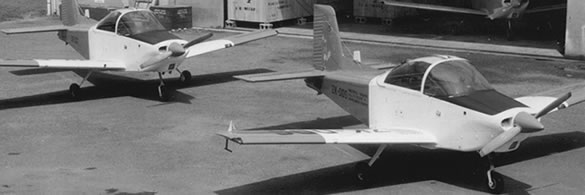Development History

The CT-4 Airtrainer was born out of two situations that occurred in the early 1970's.
Firstly the failure of the T6/24 Airtourer to meet the Royal Australian Air Force (RAAF) requirement for a basic trainer. Secondly the foresight of the AESL management of the time to exercise an already held option on the production rights to the Victa Aircruiser and adapt it into what we know as the CT-4 Airtrainer.
The adaptation was no small task as the Aircruiser was a non-aerobatic 4 place touring aircraft. However AESL, being a small, energetic and flexible company, achieved the task in short time. The first CT-4 Airtrainer s/n 001 ZK-DGY successfully first flew in February 1972 in time to meet RAAF tender requirements.
The major difference between the Aircruiser and the CT-4 Airtrainer was the many structural changes required to make the CT-4 aerobatic and able to withstand the "G" loadings associated with aerobatic operation.
More visible changes, such as a lifting "jettisonable" canopy, revised seating and interior, were also undertaken amongst many other minor changes.
In summary it was much more than a "facelift" and a whole new Aircraft type had resulted.
History tells us that the effort and the risks were worth it and AESL secured a RAAF contract to supply 37 aircraft. This order was quickly followed by another from the Royal Thai Air Force for 24 aircraft.
These orders prompted the merger of AESL with Air Parts (NZ) Ltd and with the involvement of the New Zealand Government, New Zealand Aerospace Industries was formed (but that's another story).
Production soon got underway under the NZASIL banner in 1973 with the RTAF order being the first down the newly formed production line as CT-4A models.
The RAAF order followed the RTAF order down the production line also as CT-4As the first in December 1974 and continuing throughout 1975, ending with s/n 063.
A further order from a Swiss company named Breco had been secured for 14 Aircraft and these immediately followed the last RAAF Aircraft down the line. These aircraft were designated CT-4B but were not the same as the civil CT-4Bs that were produced at a later date.
They were in fact destined for Rhodesia (Zimbabwe) which was UN sanctioned at the time and the NZ Government prevented their export and consequently they were never delivered (although paid for).
The Royal New Zealand Air Force was next to sign up for CT-4s with an order for 13 aircraft. These were produced in 1976 ending with s/n 090. Although initially they were to be CT-4D models the aircraft were data plated as CT-4B, however technically they were neither as they were not built to the Type Certificate but to a RNZAF specification.
Then the orders had run out and continuous production ceased at s/n 090.
When NZASIL announced the termination of CT-4 production the RNZAF in 1978 saved the day by ordering a further 6 aircraft as attrition airframes.
Things were quiet CT-4 production wise until 1981 when the RAAF, looking to expand their fleet of CT-4A Airtrainers, opted to purchase the Breco CT-4B aircraft that had been in storage since manufacture.
These aircraft went down the production line once again retaining their original serial numbers to be converted from the Breco CT-4B specification into the RAAF CT-4A specification.
The last aircraft was completed in May 1982 and that seemed to be it for CT-4 production. However, although NZASIL had produced its last example it wasn't the end.
Production resurfaced under the PAC banner in 1990 when the RAAF decided to civilianise it's basic training and sell off the majority of CT-4A Airtrainers.
The contract to provide this training was awarded to BAe/Ansett in NSW (now BAe Systems Australia) who in 1990 ordered 12 CT-4 Airtrainers to undertake the task. These were produced as civil CT-4B models during 1991 and 1992. The RTAF, aware that the CT-4 was back in production, placed an order for 6 CT-4B models and these were produced after the BAe/Ansett airframes taking total production to-date to 114.
During this same period the development of the CT-4E was undertaken in the hope of securing an USAF contract. Using ex Breco and ex RAAF airframe s/n 065 the development was successful, but the contract hopes not.
In May 1992 production once again stopped.
Nothing further happened until 1996 when under the new Aeromotive ownership of PAC the Aeromotive Group was successful in securing a contract to lease of 13 CT-4E Airtrainers to the RNZAF. Production recommenced with a new serial number sequence for the CT-4E starting at s/n 200.
The RTAF, ever watchful, soon placed an order for 12 CT-4E aircraft and these were produced during 1999 and 2000. In the middle of the RTAF order s/n 216 was reconfigured from RTAF specifications and is now proudly operated by Aerotec Flight Training in Queensland, Australia.
The RTAF ordered a further 4 CT-4Es and these were produced in 2001 followed in 2002 by 2 Aircraft for DSTA in Singapore.
